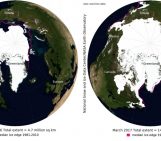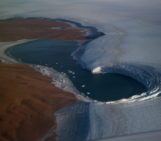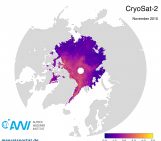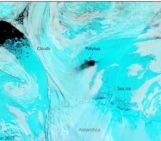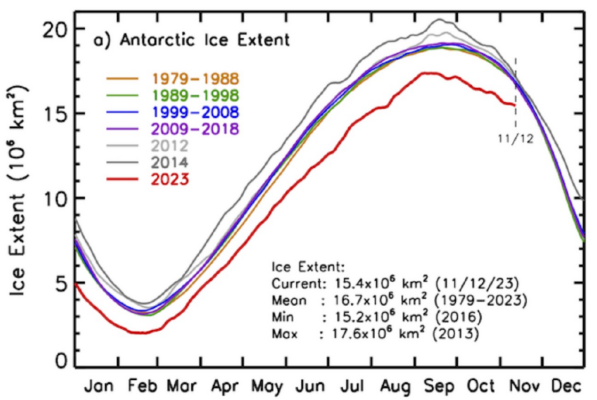
In our blog, we have written a lot about Arctic sea ice (see this post, this post and this post for recent examples). Much less has been written about Antarctic sea ice, i.e. its southern counterpart. That is not surprising as Arctic sea ice has experienced major losses since the late 1970s (beginning of satellite observations), while not much had happened to Antarctic sea ice (despite a small expansion) until around 2016. However, the picture has been changing as recent years have seen unprecedented losses of sea ice in the Antarctic region as well.
In February 2023, the minimum sea-ice extent in the Antarctic reached a record low. The sea-ice extent is the ocean area with at least 15% sea-ice concentration (see a detailed explanation in this post). Small reminder: we are in the Southern Hemisphere, so February corresponds to the end of the summer period, when sea-ice extent reaches its minimum. As you can see in Figure 1, the minimum sea-ice extent of February 2023 (red curve) was more than 1 million km² below the average of the 1979-2018 period.
What is also striking is that even if sea ice grew again between February and September 2023, as temperatures cooled down during the long austral winter, its extent remained well below the 1979-2018 average (by 1 to 3 million km²). Now that the Antarctic region is heading toward the austral summer again, the rate of ice melting seems lower than previous years (compare the red curve to other colored curves between September and now in Figure 1). However, we cannot be sure that previous levels of sea-ice extent will be reached again.
So the year 2023 has been anomalously bad for Antarctic sea ice, even making the headlines, and we need to carefully monitor what will happen in the near future. A lot of research is currently carried out to try to understand better if recent years are just outliers or if Antarctic sea ice has entered a new regime. We will update you with more information about this recent loss in Antarctic sea ice and the processes behind it in a future post.
Further reading
- To get a daily update of Figure 1 above: NASA website
- To get a detailed description of past and ongoing changes in Arctic and Antarctic sea ice: NSIDC website
- EGU CR post explaining the differences between Arctic and Antarctic sea ice
- Carbon Brief article about the recent Antarctic sea-ice record low
Edited by Maria Scheel

David Docquier is a post-doctoral researcher at the Royal Meteorological Institute of Belgium. His study focuses on the cause-effect relationships between recent summer sea-ice lows in both polar regions and their potential interacting agents. His work is funded by the Belgian Science Policy Office (BELSPO) via the RESIST project.

